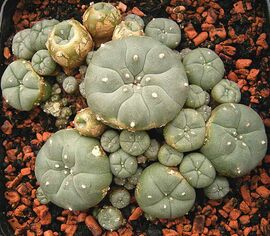This is an unofficial archive of PsychonautWiki as of 2025-08-11T15:14:44Z. Content on this page may be outdated, incomplete, or inaccurate. Please refer to the original page for the most up-to-date information.
Lophophora williamsii: Difference between revisions
Jump to navigation
Jump to search
>LockPicker m removed Category:Cactus, Category:Botany, Category:Plant |
>Graham wiki ref formatting |
||
| Line 1: | Line 1: | ||
{{Warning/PeyoteHarvesting}} | {{Warning/PeyoteHarvesting}} | ||
{{BotanyBox/Lophophora williamsii}} | {{BotanyBox/Lophophora williamsii}} | ||
'''''Lophophora williamsii''''', also known as '''peyote''' or '''peyotel''', is a slow growing spineless cactus with psychoactive alkaloids like [[mescaline]] and [[pellotine]].<ref> | '''''Lophophora williamsii''''', also known as '''peyote''' or '''peyotel''', is a slow growing spineless cactus with psychoactive alkaloids like [[mescaline]] and [[pellotine]].<ref>{{cite journal | vauthors=((Fujita, M.)), ((Itokawa, H.)), ((Inoue, J.)), ((Nozu, Y.)), ((Goto, N.)) | journal=Yakugaku Zasshi: Journal of the Pharmaceutical Society of Japan | title=[On the cactus-alkaloids of Lophophora williamsii var. caespitosa (kobuki-ubadama)] | volume=92 | issue=4 | pages=482–489 | date= April 1972 | issn=0031-6903 | doi=10.1248/yakushi1947.92.4_482}}</ref> Native North Americans are likely to have used peyote, often for spiritual purposes, for at least 5,500 years.<ref>{{cite journal | vauthors=((El-Seedi, H. R.)), ((Smet, P. A. G. M. D.)), ((Beck, O.)), ((Possnert, G.)), ((Bruhn, J. G.)) | journal=Journal of Ethnopharmacology | title=Prehistoric peyote use: Alkaloid analysis and radiocarbon dating of archaeological specimens of Lophophora from Texas | volume=101 | issue=1–3 | pages=238–242 | date= October 2005 | url=https://linkinghub.elsevier.com/retrieve/pii/S0378874105002990 | issn=03788741 | doi=10.1016/j.jep.2005.04.022}}</ref> | ||
==Distribution and habitat== | ==Distribution and habitat== | ||
==Etymology== | ==Etymology== | ||
The word peyote is the Spanish form of the ancient Nahuatlan word '''peyotl'''. Some etymologist suggested that this word is derived from the aztec word "pepeyoni" (means to excite) or "pepeyon" (to activate).<ref> | The word peyote is the Spanish form of the ancient Nahuatlan word '''peyotl'''. Some etymologist suggested that this word is derived from the aztec word "pepeyoni" (means to excite) or "pepeyon" (to activate).<ref>{{cite journal | vauthors=((Schultes, R. E.)) | journal=Botanical Museum leaflets, Harvard University | title=Peyote (Lophophora williamsii) and Plants confused with it | volume=5 | issue=5 | pages=61–88 | date=19 November 1937 | url=https://www.biodiversitylibrary.org/part/295106 | issn=0006-8098 | doi=10.5962/p.295106}}</ref> de Molina claimed that it is derived from the Nahuatlan word "peyutl" which means "silk cocoon or caterpillar's cocoon".<ref>{{cite book | vauthors=((Anderson, E. F.)) | date= 1996 | title=Peyote: the divine cactus | publisher=University of Arizona Press | edition=2nd ed | isbn=9780816516537}}</ref> | ||
==External links== | ==External links== | ||
Revision as of 18:10, 21 July 2022
Please avoid harvesting peyote in its natural habitat. Peyote populations are rapidly declining in nature due to over-harvesting by non-indigenous peoples. As a result, it is currently a threatened species.[1][2] Those who wish to consume peyote are encouraged to grow their own or use alternative mescaline-containing cactus species such as San Pedro or Peruvian Torch. |
| Lophophora williamsii | |
|---|---|
 Peyote in a pot. |
|
| Taxonomical nomenclature | |
| Kingdom | Plantae |
| Unranked | Angiosperms |
| Unranked | Eudicots |
| Unranked | Core eudicots |
| Order | Caryophyllales |
| Family | Cactaceae |
| Genus | Lophophora |
| Species | L. williamsii |
| Common nomenclature | |
| Common names | Peyote, Peyotel (in Latin America) |
| Constituents | |
| Active constituents | Mescaline, Pellotine, Hordenine, etc. |
Lophophora williamsii, also known as peyote or peyotel, is a slow growing spineless cactus with psychoactive alkaloids like mescaline and pellotine.[3] Native North Americans are likely to have used peyote, often for spiritual purposes, for at least 5,500 years.[4]
Distribution and habitat
Etymology
The word peyote is the Spanish form of the ancient Nahuatlan word peyotl. Some etymologist suggested that this word is derived from the aztec word "pepeyoni" (means to excite) or "pepeyon" (to activate).[5] de Molina claimed that it is derived from the Nahuatlan word "peyutl" which means "silk cocoon or caterpillar's cocoon".[6]
External links
References
- ↑ Martin Terry (Sul Rose State Univ., A. (19 November 2009). "IUCN Red List of Threatened Species: Lophophora williamsii". IUCN Red List of Threatened Species.
- ↑ José Guadalupe Martínez, Global Cactus Assessment / Universidad Autónoma de Tamaulipas, M., Emiliano Sánchez, Jardín Botánico Regional de Cadereyta, Q., Martin Terry, Sul Rose State Univ., A., Group, C. G.-H., IUCN S. C. & S. P. S. (18 November 2009). "IUCN Red List of Threatened Species: Lophophora diffusa". IUCN Red List of Threatened Species.
- ↑ Fujita, M., Itokawa, H., Inoue, J., Nozu, Y., Goto, N. (April 1972). "[On the cactus-alkaloids of Lophophora williamsii var. caespitosa (kobuki-ubadama)]". Yakugaku Zasshi: Journal of the Pharmaceutical Society of Japan. 92 (4): 482–489. doi:10.1248/yakushi1947.92.4_482. ISSN 0031-6903.
- ↑ El-Seedi, H. R., Smet, P. A. G. M. D., Beck, O., Possnert, G., Bruhn, J. G. (October 2005). "Prehistoric peyote use: Alkaloid analysis and radiocarbon dating of archaeological specimens of Lophophora from Texas". Journal of Ethnopharmacology. 101 (1–3): 238–242. doi:10.1016/j.jep.2005.04.022. ISSN 0378-8741.
- ↑ Schultes, R. E. (19 November 1937). "Peyote (Lophophora williamsii) and Plants confused with it". Botanical Museum leaflets, Harvard University. 5 (5): 61–88. doi:10.5962/p.295106. ISSN 0006-8098.
- ↑ Anderson, E. F. (1996). Peyote: the divine cactus (2nd ed ed.). University of Arizona Press. ISBN 9780816516537.